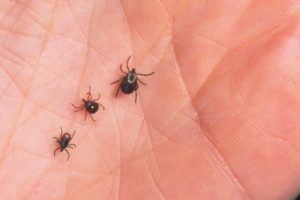
When Are Ticks Most Active?
Ticks are most active in the warm months of the year. Adult ticks and nymphs are active March through September, with larvae active in the later summer and fall months — the same months when we are enjoying the outdoors. Nymphs are immature pinhead ticks and are actually the most likely to transmit Lyme disease or another tick-borne infection to humans than ticks at other stages, according to the CDC. Less than two millimeters in size, nymphs can bite people and remain virtually undetected. They can also burrow into your or your pet’s skin.
Where Do Ticks Hide?
It may seem as though ticks drop down from tree branches, because they’re often found hidden in hair. However, they actually start closer to the ground. Favorite hiding spots include naturalized or unmown areas with weeds and tall grasses, especially when those spots are humid and shady. The trick is to be vigilant about keeping up with mowing and not letting grass grow to a height of 5 or 6 inches. If you miss a week and the grass gets tall, it is a good idea to use the bagging attachment with your lawn mower because leaving those long lawn clippings behind creates the perfect environment for ticks. Ticks typically move onto humans or animals that brush against grass or weeds when passing by. Then ticks climb upward and find a spot to bite and feed.
Why Is Tick Control Important?
Some of the diseases that ticks can transmit from animals to humans include plague, Lyme disease, Rocky Mountain Spotted Fever, Bartonellosis, and others. Tick control is important not just to take care of pets, but also to prevent establishing a transmission cycle where the pathogens can be transmitted to the humans in the household. Tick problems do not go away on their own, they multiply. Ticks that carry the bacteria responsible for Lyme disease typically lay eggs in batches of 3,000 or more. Some types of ticks lay up to 15,000 eggs before they die. No US region is free of ticks. Reactions to tick bites range from mild itching to serious, even deadly conditions.
How Can You Protect Against Ticks?
Fortunately, a bit of preventative maintenance and some professional assistance can help keep your lawn tick-free. If you think you might have ticks in your yard, you can perform a simple test called a tick drag. Cut a swatch of fabric about 5” by 5” and attach it to a long pole. While wearing long pants and tall socks to protect your legs, drag the fabric over tall grass and overgrown plants in your yard, particularly on the border of wooded areas. If there’s a tick infestation, ticks will likely latch onto the fabric in search of a meal. Keep areas free of tall grass, weeds, and garden debris. Place outdoor play and entertainment areas in sunny, airy spots, away from tick-prone areas. Mow often, mulch if your lawn is near an unkempt wooded area, consider putting down a border of mulch or gravel. Sevin insect killer ready to spray does the mixing and measuring for you — just attach it to a garden hose and go. Use it on the grass, shrubs, groundcover, and other places where ticks hide. The most important step you can take to rid your yard of ticks is destroying their preferred habitats. If you have a serious tick infestation or if your DIY doesn’t work, consider calling a professional pest control service. Not only will a professional pest control company have the proper pesticides needed to kill ticks, but the company’s experts will also have specific recommendations for your yard and home. Most importantly, eliminate existing ticks with effective tick control treatment.
In addition to taking steps to getting rid of ticks from your yard, make sure you take common-sense measures to keep ticks off your body and away from your home by doing the following:
- Always wear tick repellent when going into wooded areas.
- Whenever possible, keep children and pets from playing in the overgrown brush on the borders of your lawn.
- Treat all pets regularly with appropriate collars, medication, sprays, and shampoos.
Green & Grow’s Flea & Tick Control
We will assess your lawn for a variety of dangerous pests like fleas and ticks that can damage your turf and harm your family. We provide 3 applications of insecticide to remove the fleas and ticks safely and efficiently.
> Learn More
Contact us (859-314-LAWN) for more information or a free instant quote!
—
 About Green & Grow
About Green & Grow
Green & Grow is a full-service lawn care company specializing in fertilization & weed control, aeration & seeding, insect control, and more!
- Fertilization & Weed Control
- Aeration & Seeding
- Mosquito Control
- Flea & Tick Control
- Armyworm Control
- Emerald Ash Borer Treatment
- Commercial Snow Removal

 About Green & Grow
About Green & Grow